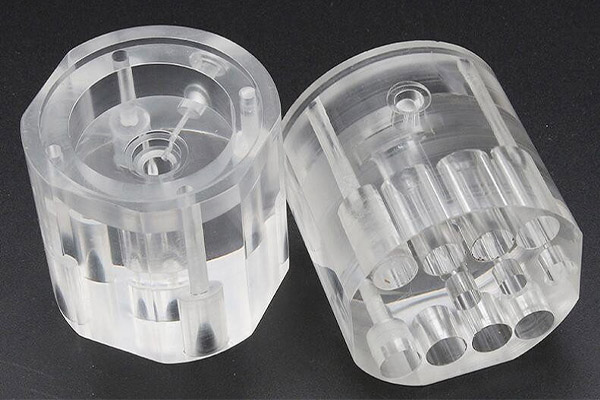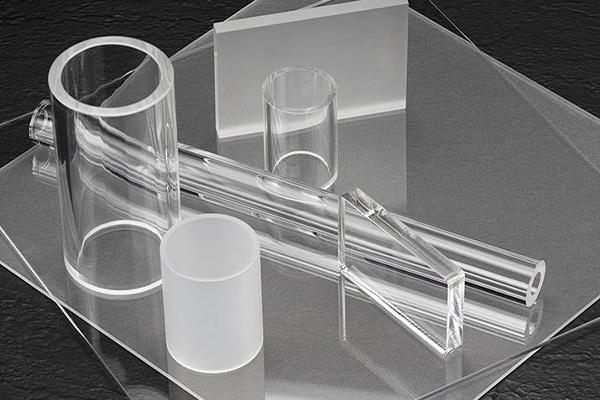CNC Acrylic: Custom PMMA Machined Parts Manufacturing
One of the most widely used methods for producing acrylic is CNC acrylic machining. Acrylic components are used in many industries. Consequently, it becomes critical to examine its manufacturing procedures.
You can find a comprehensive guide to CNC acrylic in this article. The greatest advice for machining acrylic is also included. Let’s first discuss what acrylic is and why it’s significant.

What is Acrylic?
Acrylic, also known as Polymethyl methacrylate (PMMA), is a rigid and transparent thermoplastic material widely utilized across industries as a shatterproof alternative to glass. It exists in various forms such as small granules, pellets, or sheets.
Machinists employ diverse thermoplastic processes, including compression molding, extrusion, and injection molding, for CNC acrylic cutting. Some manufacturers opt for cell casting in their CNC acrylic designs. Notably, acrylic boasts a high molecular mass, rendering it exceptionally robust and fully recyclable.
Properties of CNC Acrylic
- Surface Hardness:
Acrylic is a lightweight, tough, and durable thermoplastic with excellent scratch resistance and dimensional stability, featuring a density ranging from 1.17 g/cm³ to 1.20 g/cm³. - UV Stability:
Highly resistant to UV light, acrylic ensures stability even during prolonged exposure to sunlight, making it an ideal choice for outdoor applications. - Transmittance:
With a refractive index of 1.49, acrylic provides up to 92% light transmittance, surpassing glass and other plastics. This exceptional optical clarity and environmental stability make it suitable for various outdoor applications. - Chemical Resistance:
Aqueous solutions of laboratory chemicals, including cleaners, alkalis, detergents, and dilute inorganic acids, do not affect acrylic, making it highly resistant to chemical damage.
Processes for PMMA Fabrication
Acrylic, or Polymethyl methacrylate (PMMA), lends itself to a diverse array of machining methods suitable for various applications. Depending on the desired design, acrylic fabrication may involve multiple processes, including the following:
CNC Machining
PMMA’s exceptional properties make it suitable for applications requiring precision and superior surface finish. CNC acrylic machining is a preferred process for fabricating acrylic materials. Its rigidity and strength make CNC acrylic machining the ideal solution, offering accurate results aligned with input parameters and minimal waste.
Injection Molding
Like other plastics, acrylic can be molded into specific shapes by heating and placing it into a mold to cool and harden. Injection molding, widely used for dishware, and rotational molding, creating hollow plastic parts, are common procedures.

Acrylic Extrusion
Acrylic extrusion enhances material processing and often precedes bonding or lamination stages. Employed for piping, tubing, and sheeting components, acrylic extrusion comes in two forms: profile extrusion and sheet extrusion, both delivering reliable results.
Acrylic Welding
This binding operation uses heat to join acrylic pieces without the need for adhesives. Various methods, including contact welding, high-frequency vibration, spinning, or hot gas emissions, are employed in acrylic welding.
Compounding (Blending)
Compounding involves mixing melted acrylic pieces before molding to create a product with combined features, ensuring enhanced durability compared to raw materials. This process is crucial for achieving desired product quality.
In addition to these processes, PMMA’s transparency and hardness allow it to serve as a material for 3D printing, requiring slightly higher temperatures for optimal results.
Benefits of Utilizing Acrylic for Your Parts
Acrylic stands out as a favored material, attributed to its exceptional attributes that render machined acrylic parts durable, transparent, and resistant, making them suitable for diverse applications. The advantages of acrylic encompass, but are not restricted to, the following:
- Outstanding Weathering and UV Resistance:
Acrylic exhibits remarkable durability against weathering and is highly resistant to UV radiation, making it an ideal choice for applications exposed to outdoor elements. - Dimensional Stability:
Machined acrylic parts maintain dimensional stability, ensuring consistency in size and shape over time, contributing to their reliability in various settings. - Transparency:
Acrylic’s inherent transparency allows for clear visibility, making it suitable for applications where optical clarity is crucial. - Good Rigidity:
The material offers good rigidity, providing structural integrity to machined parts and enhancing their overall stability. - Abrasion Resistance:
Acrylic showcases good abrasion resistance, allowing for easy removal of surface scratches through polishing, ensuring a smooth and flawless appearance. - High Gloss and Hardness after Modification:
Modified acrylic parts attain high gloss and hardness, enhancing their aesthetic appeal and overall durability, contributing to the longevity of machined components.
Applications of CNC Acrylic Parts
Acrylic, also known as PMMA, gained popularity during World War II, finding initial uses in crafting gun turrets, canopies, windshields, and various military applications. Over time, its versatile properties led to widespread adoption in diverse commercial sectors, including:
Automotive Industry
Acrylic sheets are integral in designing car windows, panels, motorcycle windshields, and fenders. Colored sheets are preferred for various car components such as interior light covers and indicator light covers, thanks to acrylic’s excellent formability and surface hardness.
Lighting and Electronics
Acrylics enhance the light-emitting capabilities of LED lights due to their optical properties and transparency. Scratch-resistant and optically clear, acrylics are extensively used in lamp construction and various electronic equipment.
Medical and Healthcare
Acrylic’s purity and ease of cleaning make it a valuable material for medical applications, including incubators, cabinets, and devices. Its compatibility with biologics makes it an excellent choice for dental cavity fillings.
Architecture and Construction Industry
Acrylic parts find broad use in construction due to their outstanding UV and impact resistance. Common applications include door and window profiles, panels, canopies, and façade designs.
Common Products Made from Acrylic Sheets:
- Glove boxes
- Displays and signs
- Lighting fixture lenses
- Aircraft glazing
- Desiccators and dry boxes
- Radiation shields
- Sinks, knobs, batons, and baths
- Retail fixtures
- Windows and glass alternatives
- Automotive components, including fascia panels, steering wheels, and badges
Tips for Optimal CNC Acrylic Machining Results
Utilizing CNC acrylic system presents numerous possibilities for various applications. To ensure successful manufacturing, consider the following tips for achieving a smooth finish in your CNC acrylic cutting:
Tip 1 – Secure Your Material
Machining acrylic demands precision and careful operations. Properly securing your acrylic to the machine is crucial to avoid excess vibration that could compromise the product’s quality.
Tip 2 – Use the Correct Bit
Avoid using wood bits for cutting acrylic on CNC machines. Opt for a bit specifically designed for acrylic cutting to achieve the best results.
Tip 3 – Set the Right Feed Rate
Using the correct feed rate is essential for obtaining clean cuts without melting the plastic. Adjust the feed rate according to your specific machining process.
Tip 4 – Use the Correct Revolution Per Minute (RPM)
Correlate the RPM with the feed rate, adjusting settings based on the type of acrylic being used. Faster RPM may require an increase in feed rate to prevent material melting.
Tip 5 – Set the Pass Depth at the Correct Inch
For optimal results, set the pass depth to be half the diameter of the bit for most materials. Some materials may require a specific pass depth, such as 0.0625”, for the best outcomes.
Tip 6 – Cut Direction is Important
Conventional or clockwise cutting direction tends to produce superior results, aligning well with the rotating cutter’s direction.
Tip 7 – Don’t Forget the Ramp Feature
When working with CNC acrylic, employing a ramp is advisable. This feature allows the bit to enter the material at the required angle rather than plunging straight down. A smooth ramp between 1 to 3 inches is recommended for optimal results.
CNC Acrylic Machining Services
One of the best materials for CNC systems to work with is acrylic. With this material, you can accomplish a lot. You have been guided through the numerous benefits and uses of CNC acrylic by this article. Additionally, you now possess the best guidelines for acrylic machining. It’s time for your CNC acrylic parts to be customized.
We are always prepared to produce the best results for CNC acrylic machining needs in a timely manner. Our skilled and informed engineers assist us in carrying out an efficient CNC acrylic milling procedure.
Our top goal at Sungplastic is providing high-quality services. As a result, you know that the parts you are receiving meet the highest standards. We perform full-dimensional and first article inspections upon your request. All of this is available to you at reasonable prices.
Please get in touch with us.
FAQ about CNC Acrylic
Is Glass Worse Than Acrylic?
Comparing acrylic sheets to glass and other plastic materials, there are a number of benefits. They are lightweight and have a much higher surface hardness. They have strong UV stability and are resistant to shattering.
Is Acrylic Safe to Use?
Acrylic is thought to be safe and has few potential hazards. It is free of Bisphenol A (BPA), which is present in a lot of other plastics. Research indicates that BPA may pose dangerous health risks. Your safety is assured because acrylic is BPA-free.
Can I Use A Router To Cut Acrylic?
Acrylic can be cut with a router to make straight or curved cuts. For curved cuts, a router with a guide and collar will work best. Using a specialized bit on a CNC router is necessary when cutting acrylic. Additionally, cutting steadily and maintaining the acrylic’s coolness throughout would be beneficial.
Get a free quote and design analysis today.
We’ll reply to you within 6 working hours.
We respect your privacy.
+86 139 2927 4777 (WhatsApp, Wechat)
